The Jewish Traveler
Exploring Turkey’s Jewish Delights
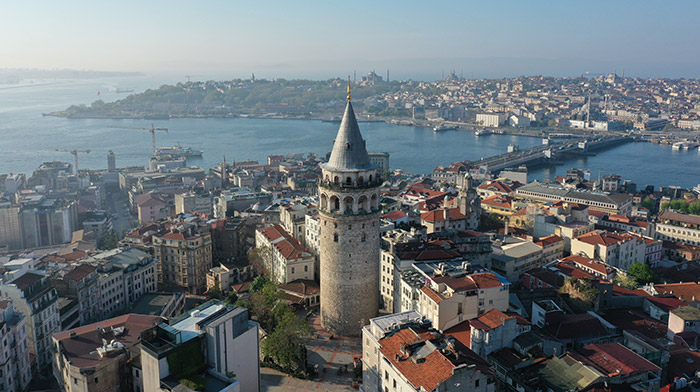
Istanbul is a feast for the senses. Izmir enchants with its sparkling Aegean coastline and jewel-box synagogues. But just a few years ago, I’m unsure what my reaction would have been to an invitation to visit such illustrious Turkish cities.
Without a doubt, I would have wanted to experience Istanbul—the fabled and literal spot where East meets West along the Bosporus, the 25-mile-long channel that connects the Black and Marmara Seas. I would have wanted to explore ancient Constantinople’s 21st-century manifestation, with its unparalleled sweep of towering minarets and domes surrounded by water, the whole scene turned golden by the sun.
But that pull to go would have been tempered by concern over the Turkish government’s moves regarding Israel. Turkey had downgraded relations with Israel in 2011, in response to the May 2010 flotilla incident in which nine Turkish activists aboard the Mavi Marmara were killed by Israeli forces as they tried to break the barricade of Gaza. What followed was close to 10 years of strained relations and public denunciations of Israel. Indeed, since Turkey became the first Muslim nation to recognize the Jewish state, in 1949, relations between the two neighbors had been a case of two steps forward, one step back.
The situation shifted again last year, when rapprochement between the nations culminated in the restoration of full diplomatic ties in August 2022. Turkey’s motives for reconciliation, most observers agree, were a two-part political calculation. First, Turkey sought to burnish its image in Washington’s political corridors and among influential Jewish groups that might lobby the United States government on its behalf. Normalizing relations with Israel might help accomplish that aim, the theory goes. At the same time, the country sought increased economic engagement with Israel and began to look to international tourism, which took a major hit during two years of Covid lockdowns, as a means to bolster its sluggish economy.
The Turkish republic’s charm offensive may be one explanation for the Jewish media trip I joined last fall. The nation’s newfound openness is welcome news for passport-holders eager to explore cosmopolitan Istanbul as well as Turkey’s third-largest city, Izmir, home to the nation’s second-largest Jewish community.
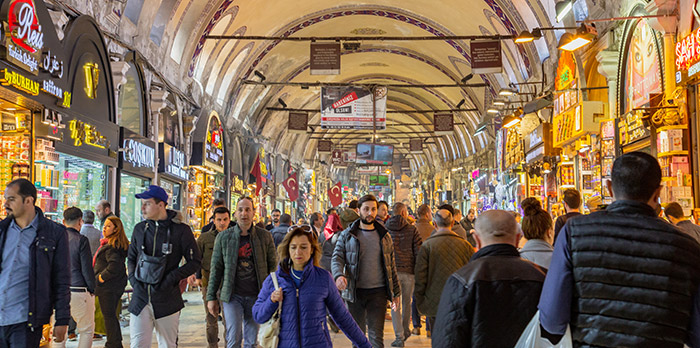
Whether you’re exploring the European or Asian side of Istanbul—Turks refer to each as “the other side,” or “karsi taraf,” depending on where they are standing—the bustling crowds and splendor of Byzantine- and Ottoman-era architecture fronting the Bosporus and the Golden Horn are magical. The city’s urbane nature coupled with its millennia of recorded history means that Istanbul regularly appears atop lists of most-visited international metropolises. All those tourists translate to a cacophony of languages overheard when strolling the teeming streets of Istanbul, which, with 15.8 million residents, is Europe’s largest city.
One language you’re not likely to hear is Ladino. Istanbul’s approximately 17,500 Jews, who are almost all Sephardi, for the most part grew up with parents or grandparents who spoke the language, also known as Judeo-Spanish. But although linguists estimate that 8,000 Ladino speakers remain in Turkey, few among the younger generations speak it.
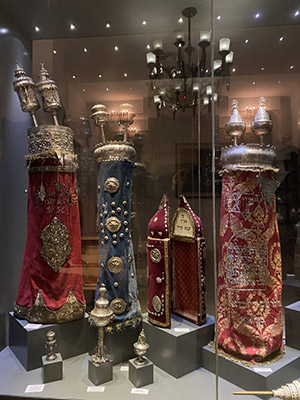
“The language is in the category of other dying languages,” confirmed Nisya Isman Allovi, the 43-year-old director and curator of the Quincentennial Foundation Museum of Turkish Jews in Istanbul. “I don’t speak it, but I understand it. It is a nostalgic language for me, and of course I would like to hear more Ladino. But it just isn’t a priority.”
Allovi and other prominent Jews, however, are committed to preserving Ladino texts. As director of Turkey’s largest Jewish museum, Allovi oversees a rich collection that includes 18th-century volumes of the Me’am Lo’ez, a commentary on the Torah written in Ladino. Me’am Lo’ez roughly translates to “The Tribe That Speaks a Foreign Language” and was an initiative first championed by Rabbi Yaakov Culi in Constantinople in 1730, when few Jews in the Ottoman Empire could read Hebrew.
Also housed at the museum are issues of the community paper Salom, which was published in Ladino from its founding in 1947 through 1984, when it switched to Turkish. Today, there are 6,000 subscribers to El Amaneser (the dawn), a monthly sister publication to Salom that is believed to be the only Ladino newspaper in the world.
Ladino’s slow decline is the result of two forces, one from within and one from outside the Jewish community. With the arrival in Turkey of Alliance Israélite Universelle schools in the late 19th century, French became the preferred language of the Jewish cultural elite. After Turkey’s independence in 1923, the patriotic fervor that the father of the republic, Mustafa Kemal Ataturk, ignited, led to secularizing reforms including the “Citizen, Speak Turkish” campaign. As the 20th century progressed, fewer Jews felt comfortable speaking Ladino.
Further draining the country of Ladino-speakers, between 1948 and 1954, nearly 35,000 predominantly lower-class Jews made aliyah—40 percent of the population—largely for economic reasons. Today, fewer than 20,000 Jews live in Turkey, most of them well-educated, economically successful and somewhat insular.
Just as Ladino traveled with Sephardi Jews from the Iberian Peninsula to the Ottoman Empire, so, too, did the design of their houses of worship. Configured in what’s called a central plan, most Turkish synagogues feature a tevah (bimah) in the middle of the sanctuary, facing the hechal (ark), with benches wrapping around the main floor and balcony seating for women. Close to 20 Sephardi synagogues bearing this layout are scattered throughout Istanbul, the majority on the European side.
Beyond Istanbul, similar synagogues can be found in, among other cities, Izmir, Ankara, Bursa and, in the south, Antakya, which suffered massive casualties after the devastating Kahramanmaras earthquake in February that claimed more than 50,000 victims in Turkey and neighboring Syria.
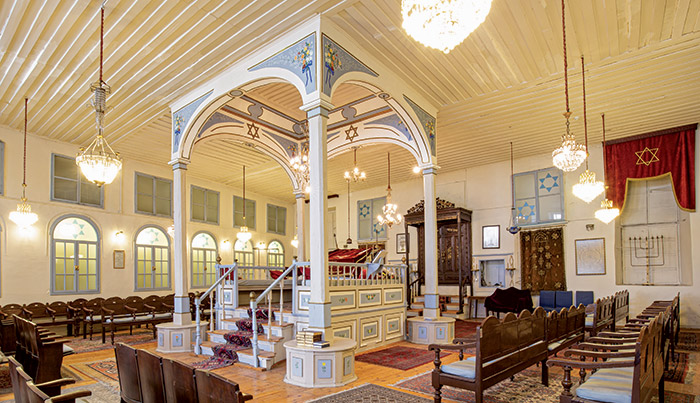
Hop a short flight from Istanbul Airport or embark on a scenic five-hour road trip southwest to reach Izmir. During Greek, Roman and Ottoman rule, the area was known as Smyrna; its most impressive sight from antiquity is the Agora of Smyrna, originally erected in the fourth century BCE. Curved picturesquely around the bay of the Gulf of Izmir, the city today welcomes throngs of cruise passengers who disembark for day trips to the archaeological wonders of Ephesus, Pergamon and Sardis.
But fascinating Jewish history exists closer to port, in the city center. There, Izmir’s labyrinthine First Jewish Quarter winds around a section of the Kemeralti bazaar crowded with fish peddlers, produce merchants and bakeries. It is the restoration and promotion of the quarter’s sights that energize native son Nesim Bencoya. As the driving force behind the Izmir Jewish Heritage Project, Bencoya, the former director of the Haifa Cinematheque who returned to Izmir in 2010 after 40 years in Israel, helps to promote interest in Izmir’s Jewish past.
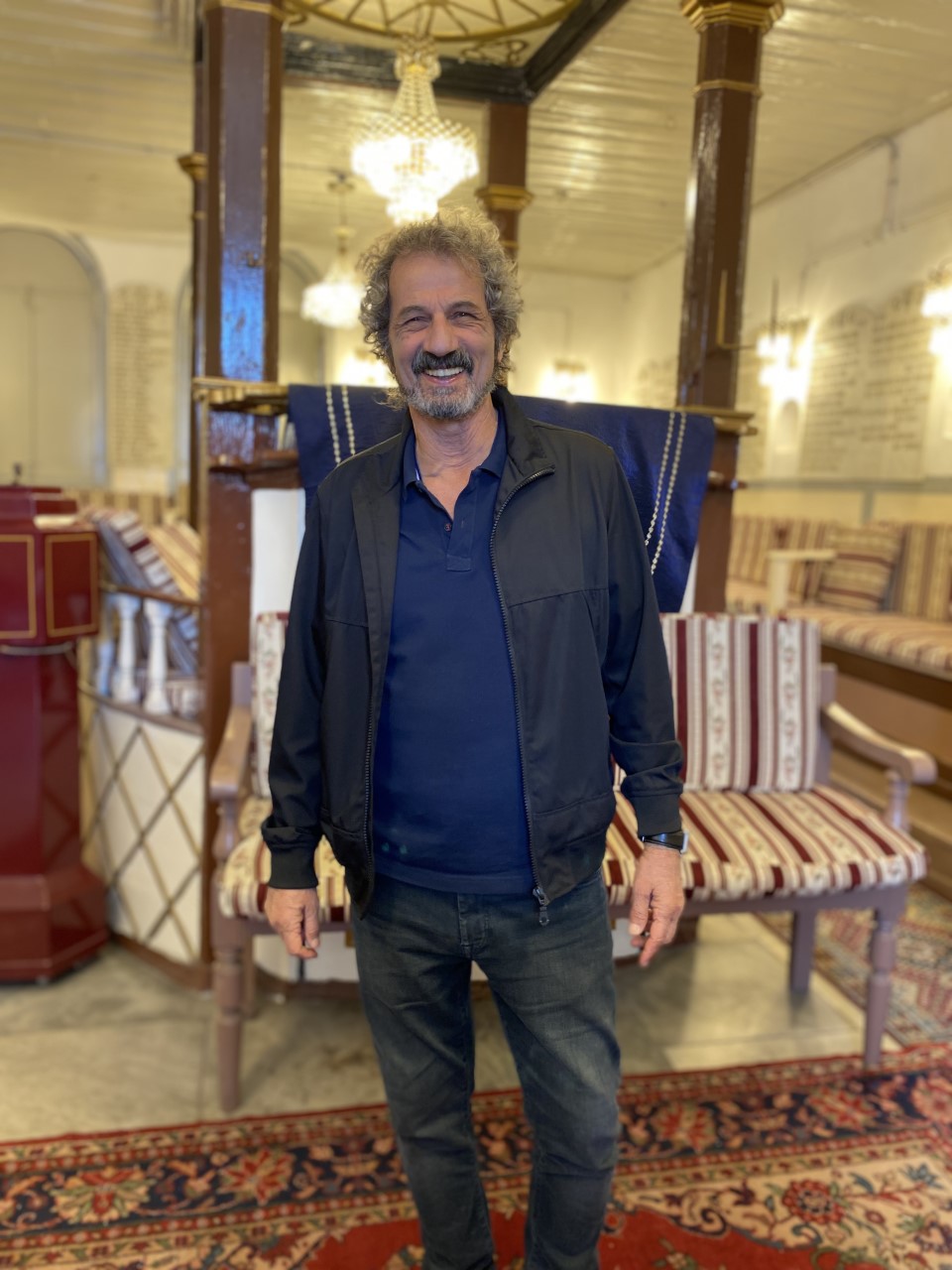
Bencoya hustled our group of writers through atmospheric stone alleys and a series of exquisitely restored synagogues that mostly date from Izmir’s Jewish golden age in the 17th century. The enthusiasm for his work was palpable as he passionately recounted colorful tales about the Jews who once walked these lanes, including the infamous Sabbatai Zevi, whose life story Benacoya shared:
Born in the city in 1626, as a teen, Sabbatai had been more interested in Jewish mysticism than Torah. In 1648, he declared himself the messiah, a move that prompted the rabbis to banish Sabbatai from the city. What followed were years of journeying through Ottoman lands including Salonika, Alexandria and Jerusalem, among other Jewish centers, where the charismatic Sabbatai attracted legions of followers taken by his notions of ascetic belief, fasts and focus on redemption.
In 1665, Sabbatai returned to Izmir en force. He and his disciples wrested control of the Portugal Synagogue and called both women and men to the Torah.
His movement, however, was short lived. In Constantinople in 1666, Sabbatai was arrested and sentenced to either conversion to Islam or death. He chose the former, and until his death in 1676, practiced some form of Judaism in secret.
Fascinating historical tales and synagogue treasures notwithstanding, Bencoya told me that the motivation for his tireless work derives from something far more crucial to the well-being of the city’s Jews, who now number around 1,000.
“Antisemitism expresses itself in many forms,” he said. “But the common reason for it is a lack of knowledge about Judaism, Jewish people and Jewish traditions. The Izmir Jewish Heritage Project, by exposing our culture to non-Jews, is filling this gap of ignorance with true knowledge.”
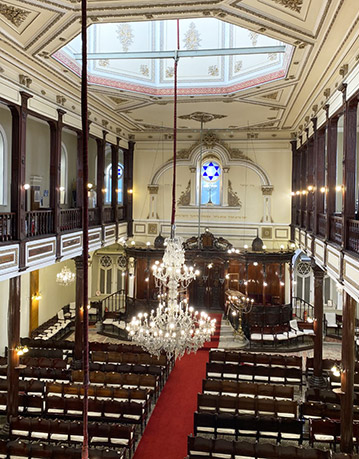
Photo by Libby Barnea.
One way that Bencoya is filling those gaps is through the five-year-old Izmir Sephardic Culture Festival, held annually during Hanukkah in the quarter’s synagogues. The popular festival attracts close to 5,000 mostly non-Jewish attendees to a series of concerts, food tastings, art shows and Ladino performances.
“This language is rapidly disappearing, and not only the vocabulary, but a whole culture is in real danger,” he told me. “Something had to be done.”
So with his characteristic determination, Bencoya recruited two groups to perform in Ladino—one of which, Salut de Smyrne, features non-Jewish musicians who had never heard the language.
“Two years ago, I met a band specializing in ethnic music,” he said of Salut de Smyrne. “I asked if they would be interested in playing Ladino songs. Obviously, they did not know what I was talking about. But, after they listened to a few songs, they accepted my proposal. Not being Jewish, we worked on pronunciation, meaning of the lyrics and Sephardi culture.
“Salut de Smyrne today performs Ladino music everywhere and enriches its repertoire continuously,” Bencoya continued. “This is not exactly teaching Ladino as a language, but it is a good way to make Ladino relevant in the hope that Izmir Jews will be excited to follow this example, to be proud of their language and adopt it in various ways.”
After all, there are 530-plus years of remarkable heritage for the Jewish communities of Izmir and Istanbul to take pride in—and for keen travelers to engage with when they visit this captivating land.
IF YOU GO
Start your planning at Turkey’s official tourism portal, Go Turkiye. For Jewish resources such as kosher food and services, consult the chief rabbinate’s office in Istanbul or Chabad, which is led by Rabbi Mendy Chitrik (mendy@rabbimendy.com).
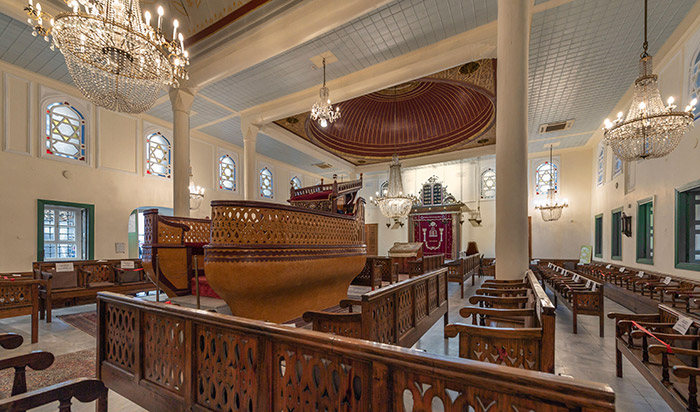
Photo by Ayhan Altun/Alamy.
ISTANBUL: WHAT TO SEE
While Jews no longer reside in the central Galata district—best known as the site of the 13th-century Galata Tower, whose 170-foot-high observation deck offers stunning 360-degree views of Istanbul—the largest synagogue in all of Turkey, Neve Shalom, remains there, open for Shabbat, holidays and special occasions.
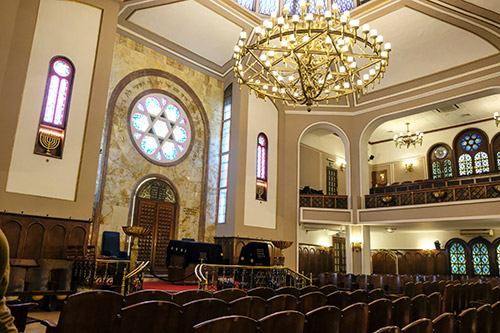
Shutterstock photo.
Built by Jews who came to the area along the northwestern banks of the Golden Horn in the early and mid-20th century, Neve Shalom features a lofty sanctuary graced with over a dozen stained-glass windows. It also houses a towering wooden ark atop a red-carpeted stage; a women’s gallery encircling the space from above; and a massive brass chandelier featuring a Magen David within its diameter.
Despite the promise of peace in its name, Neve Shalom has witnessed three terror attacks, beginning with a devastating shooting spree on the Shabbat morning of September 6, 1986, when a pair of Arab assailants murdered 22 Jews.
That fateful morning is a glaringly violent footnote to a 530-year heritage that is celebrated in the Quincentennial Foundation Museum of Turkish Jews, located directly adjacent to Neve Shalom. Over several floors, the community’s origins are recounted through sophisticated multimedia displays as well as ritual artifacts such as Torah crowns, yads, menorahs and textiles from rabbinic robes to wedding costumes.
Two blocks west from Galata tower is the Italian Synagogue, so named for the Italian Jews who inaugurated the congregation in the 19th century. The sanctuary that greets contemporary visitors was rebuilt in the 1930s. Several blocks downhill from the tower is the Ashkenazi Synagogue, founded by Austrian Jews in 1900 and today the only site of Ashkenazi worship is Turkey.
The origins of Istanbul’s Jewish community lie in the Balat neighborhood, a maze of bohemian-chic side streets along the southeastern coast of the Golden Horn. It was here, in the 1430s, that Romaniote Jews hailing from Ottoman-controlled Ahry, Macedonia, founded the Ahrida Synagogue, the oldest still functioning Jewish site of worship in Turkey. While Sephardi Jews merged with, and ultimately subsumed, the Romaniote group after their arrival in the 1490s, the space retained its original name.
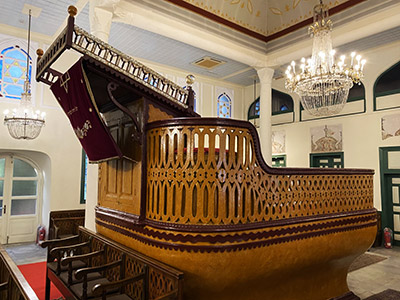
Photo by Libby Barnea.
The synagogue was rebuilt in the 16th century after a severe fire and later underwent many bouts of restoration, most recently in 1992. The domed ceiling, painted a deep red with golden line segments, tops a white-columned sanctuary whose pride of place is a highly varnished wooden tevah shaped like the prow of a ship and said to symbolize both Noah’s Ark and the vessels that brought Jews from Spain to Turkey.
Around the corner, the Yanbol Synagogue owes its founding in the late 15th century to the arrival of Jews from Yanbol, Bulgaria. The small sanctuary that welcomes modern-day visitors dates to the 18th century, when the ceiling of intricate floral motifs in hues of green, blue and yellow was painted. Both the Ahrida and Yanbol synagogues are open primarily for tourists and on High Holidays and special occasions.
Istanbul’s largest congregation today is the 100-year-old Bet Israel in Sisli, an affluent neighborhood whose Jewish population began to swell in the 1950s. An active congregation also exists in Ortakoy, at the Etz Hayyim Synagogue. Meanwhile, Bet Yaakov in Kuzguncuk is one of few extant synagogues on the Asian side of Istanbul, though its member families, originally from this area, largely live elsewhere.
Istanbul’s historical peninsula, where the Golden Horn meets the Bosporus just north of the Sea of Marmara, contains several must-see sights and indulgent experiences like the Cagaloglu Hamam.
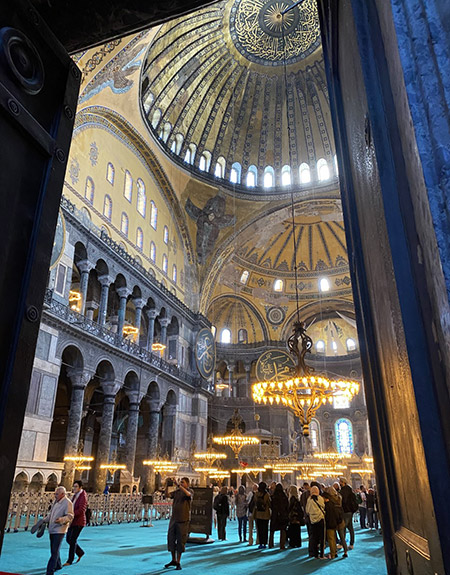
Photo by Libby Barnea
No superlative does justice to the architectural significance and resplendence of the Hagia Sophia (“Holy Wisdom”), whose pendentive dome, erected in 537 during the reign of Byzantine Emperor Justinian, capped what remained the largest basilica in Christendom for almost 1,000 years. Lavishly ornamented with marble and gold mosaics of Christian scenes such as the virgin and child—now largely obscured in keeping with the site’s designation as a mosque—it is the sanctuary’s soaring 180-foot height that most evokes spiritual grandeur. Also breathtaking is the neighboring Blue Mosque on Sultanahmet Square, completed in 1723 and renowned for its ceramic mosaics in tulip patterns, stained-glass windows, five primary domes and six minarets.
Built along the Bosporus in 1453 by Mehmet the Conqueror, the nearby Topkapi Palace features a succession of four courtyards. Among the priceless jewels and weapons in the palace’s treasury are the Spoonmaker’s Diamond, the golden- and emerald-studded Topkapi Dagger and the ceremonial armor of Sultan Mustafa III, who ruled in the 18th century. Of Jewish interest is a nondescript whitewashed building labeled “Room of the Chief Physician,” where the sultan’s doctors—who, for centuries, were Jews—lived and prepared their treatments.
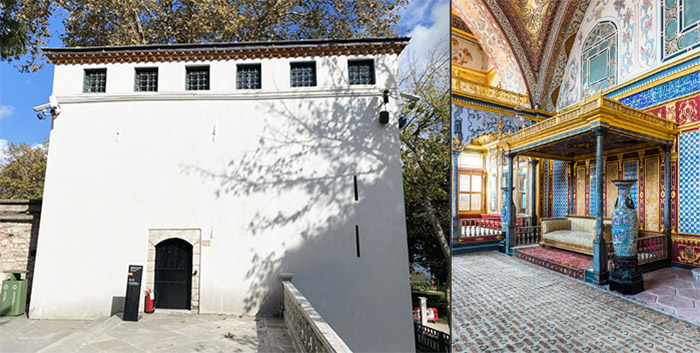
Imperial Hall (Shutterstock photo).
To conjure up the grandeur of Byzantine Istanbul stroll through the preserved outline of the Hippodrome on Sultanahmet Square. First built in 203 AD by Emperor Septimius Severus and significantly renovated by Emperor Constantine in the 320s, a number of rulers beautified the race track by placing spectacular art, often seized from throughout the empire, along the Hippodrome’s spina, or middle column. Still standing are two obelisks—the older, dating from 1490 BCE and made of pink granite, once stood at the Temple of Karnak in Luxor—and the serpent column, all that remains from a sacrificial tripod that Constantine ordered moved from the Temple of Apollo at Delphi.
Squeezed into more than 60 covered alleys, the 4,000-plus shops in Istanbul’s Grand Bazaar sell everything from handwoven rugs and Turkish cotton towels to knockoff designer goods, jewelry and cheap souvenirs. Built in the mid-15th century, the bazaar is thought to be the oldest and, according to local tourism officials, the most visited shopping mall in the world. Epicureans hungry for Turkish delight and other local treats will want to make a separate stop at the more manageable Spice Bazaar, about a 10-minute walk north in the direction of the Golden Horn.
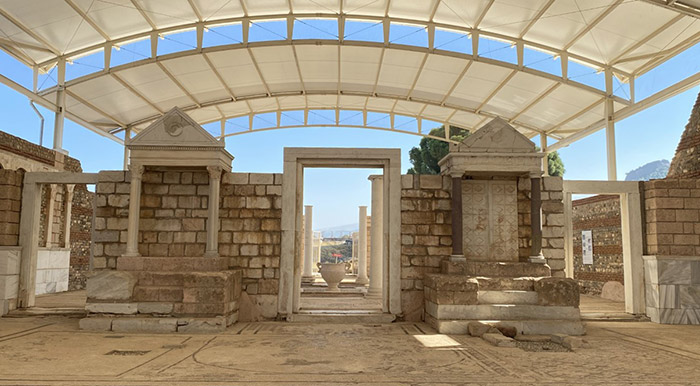
Photo by Libby Barnea.
IZMIR: WHAT TO SEE
As monolithic as Sephardi Judaism has been in Turkey since Ottoman rule, the Jewish presence actually extends back to the late Roman era, if not earlier. Archaeologists have excavated the largest known synagogue from the ancient world at Sardis, an historically significant city since the Iron Age located in western Turkey, about an hour’s drive from Izmir. The synagogue dates to the late third century C.E. and is noteworthy for its colonnaded forecourt and main hall that archaeologists believe could have accommodated almost 1,000 worshipers.
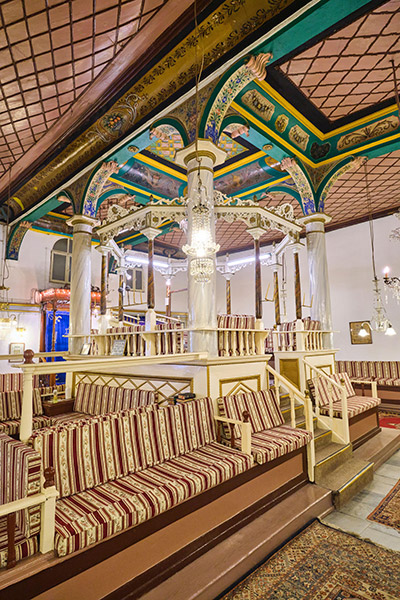
Photo by James Talalay/Alamy.
Izmir’s First Jewish Quarter, which dates to the 16th century, surrounds Kemeralti market via a maze of alleyways whose main thoroughfare is Havra (synagogue) Street. Begin your tour of the quarter’s jewel-box-like synagogues at the largest—Bikur Holim, located along the major artery of Ikicesmelik Street. (Visit the website of the Izmir Jewish Heritage Project to map out your tour.)
The synagogue was originally a large courtyard house, known as a cortijo, before it was gifted to the community in 1724 by Salomon de Ciaves, a Portuguese Dutch Jew. Today, Bikur Holim’s impressive sanctuary features a raised central tevah encircled by marble columns and an elaborately painted ceiling with floral and geometric designs of reds, yellows and green.
Next, venture into the heart of the old quarter. A onetime home of the influential Palachi family, Bet Hillel is a tiny showcase devoted to Rabbi Hayim Palachi (1788-1869) and his son Rabbi Abraham Palachi (1809-1899). The classically ornamented Sephardi sanctuaries of Etz Hayim, Shalom, Algaze and Sinyora synagogues evoke the spiritual significance of Izmir’s golden age, though some of their central plan designs have been altered.
In the mid-19th century, successful Jews looking to escape the crowded Kemeralti quarter decamped for the southern bay of Izmir, to what is now the Karatas neighborhood. Here, Jews built Bet Israel Synagogue, Izmir’s largest and most ornate, in an Italian style notable for its towering mahogany columns rising up to the women’s balcony, which also houses an exhibit on the history of Izmir’s Jewish community.
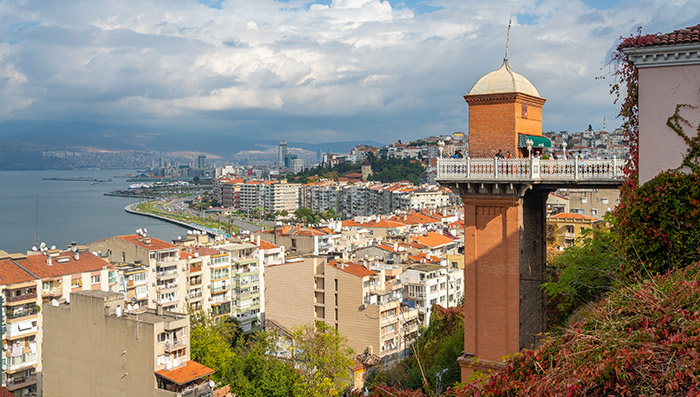
A few blocks inland from Bet Israel stands an early 20th-century engineering feat with a Jewish pedigree: The Historical Elevator, or Asansor in Turkish. The lift’s construction in 1907 was funded by Jewish businessman Nesim Levi to connect clifftop neighborhoods with Karatas’s coastal streets. Ascend to the top to take in sweeping views of Izmir’s bay. Down at sea level, explore Asansor Street, a charming alley lined with shops and cafes that was the childhood haunt of legendary Jewish singer and guitarist Dario Moreno, born David Arugete in 1921.
Don’t leave Izmir without sampling two delicacies with Sephardi origins; boyoz, an iconic local pastry made with flour, sunflower oil and tahini, and subiya, a ubiquitous drink derived from melon seeds, water and sugar.
BURSA: WHAT TO SEE
An easy day trip from Istanbul, this onetime capital of the Ottoman Empire and stop on the Silk Route is best known today as the center of Turkey’s thriving automotive production industry. The city’s Jewish community, which numbers around 20 families, dates to the late 15th century, when Jews fleeing the Inquisition arrived in Bursa during the reign of Selim II. They erected their first house of worship—Gerus Synagogue—in the early 16th century. (Gerus translates to “cast out.”)
After a restoration in 1992, the synagogue’s few remaining members are joined by an Istanbul-based gabbai for Shabbat services in the petite main sanctuary, which features a central wooden tevah below a dome painted with floral motifs. The tevah is surrounded by white columns and ringed by crystal chandeliers and red velvet benches.
Gerus Synagogue’s unofficial caretaker is Bursa-born Yosef Hazan, a Jewish businessman who splits his time between his hometown and Istanbul. According to the 50-year-old Hazan, 2,000 Jews lived here prior to the late 1940s, after which most made aliyah or relocated to Istanbul.
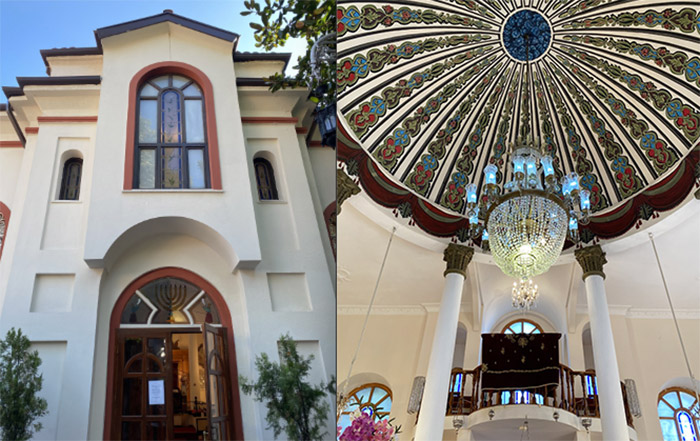
Libby Barnea, deputy editor of Hadassah Magazine, visited Turkey last year as a guest of the Turkish Ministry of Culture and Tourism.










 Facebook
Facebook Instagram
Instagram Twitter
Twitter
arlene Kupietzky says
DO YOU HAVE A GUILD THAT YOU CAN RECOMMEND FOR Istanbul?
Thank you,